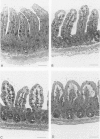Abstract
OBJECTIVE: The central question tested in this study was whether dichloromethylene-diphosphonate (CL2MDP) liposome-mediated elimination of hepatic and splenic macrophages would influence zymosan-induced bacterial translocation and the zymosan-induced generalized inflammatory response. SUMMARY BACKGROUND DATA: Both an uncontrolled activation of macrophages and the loss of intestinal barrier function have been implicated in the development of adult respiratory distress syndrome and multiple organ failure. METHODS: Macrophage elimination was accomplished by intravenous injection of 200 microL of CL2MDP-liposome suspension. Control mice received an intravenous injection of 200 microL of phosphate-buffered saline. Two days later, the animals were challenged intraperitoneally with zymosan suspended in paraffin to determine a dose-response curve (0.1, 0.5, or 1.0 mg/g body weight). Twenty-four hours after zymosan challenge, signs of systemic stress were determined, and bacterial translocation to the mesenteric lymph node, liver, spleen, and blood was measured. A separate mortality study was performed with a dose of 1.0 mg/g of zymosan suspension. RESULTS: The incidence of the systemic spread of bacteria was significantly increased in the macrophage-depleted mice. Although systemic bacterial translocation was promoted by macrophage elimination, the systemic toxic response was significantly decreased in all macrophage-depleted groups (p < or = 0.01). The 12-day mortality rate was 0% in the macrophage-depleted groups and 27% in the control group (p = 0.05). CONCLUSIONS: The lethal and toxic effects of zymosan appear to be related more to the excessive activation of macrophages than to the systemic spread of bacteria.
Full text
PDF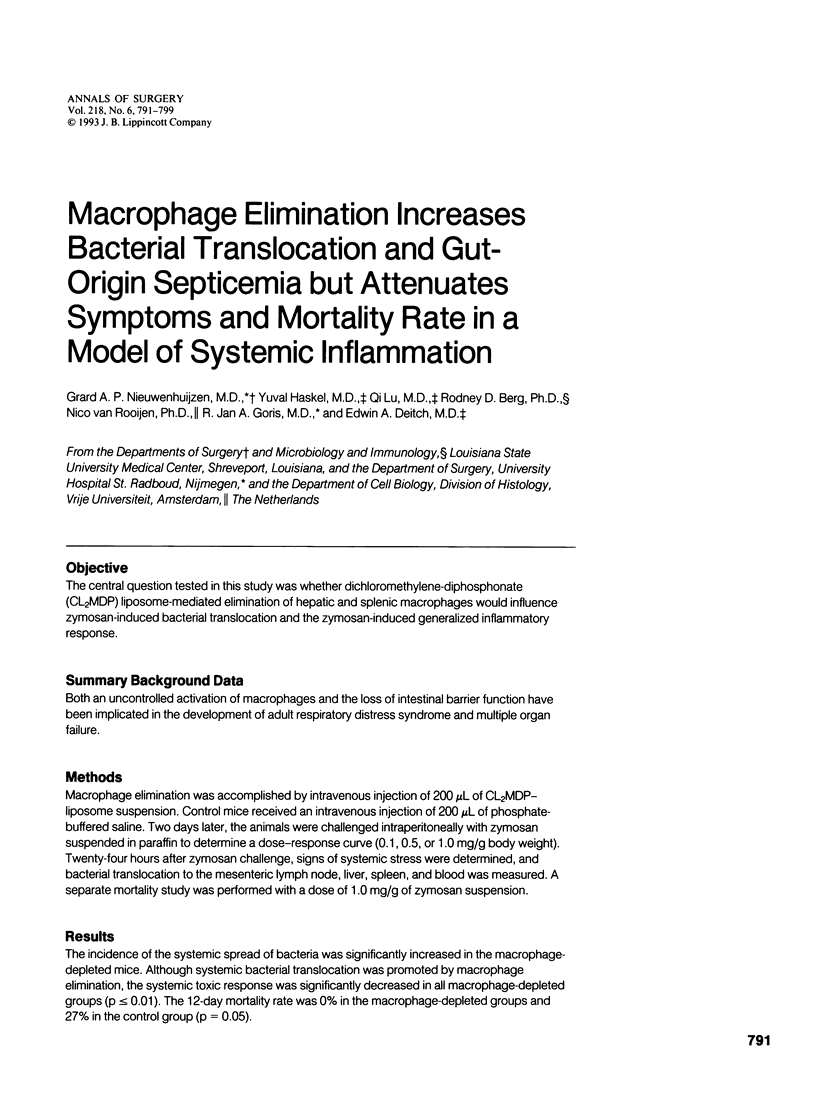
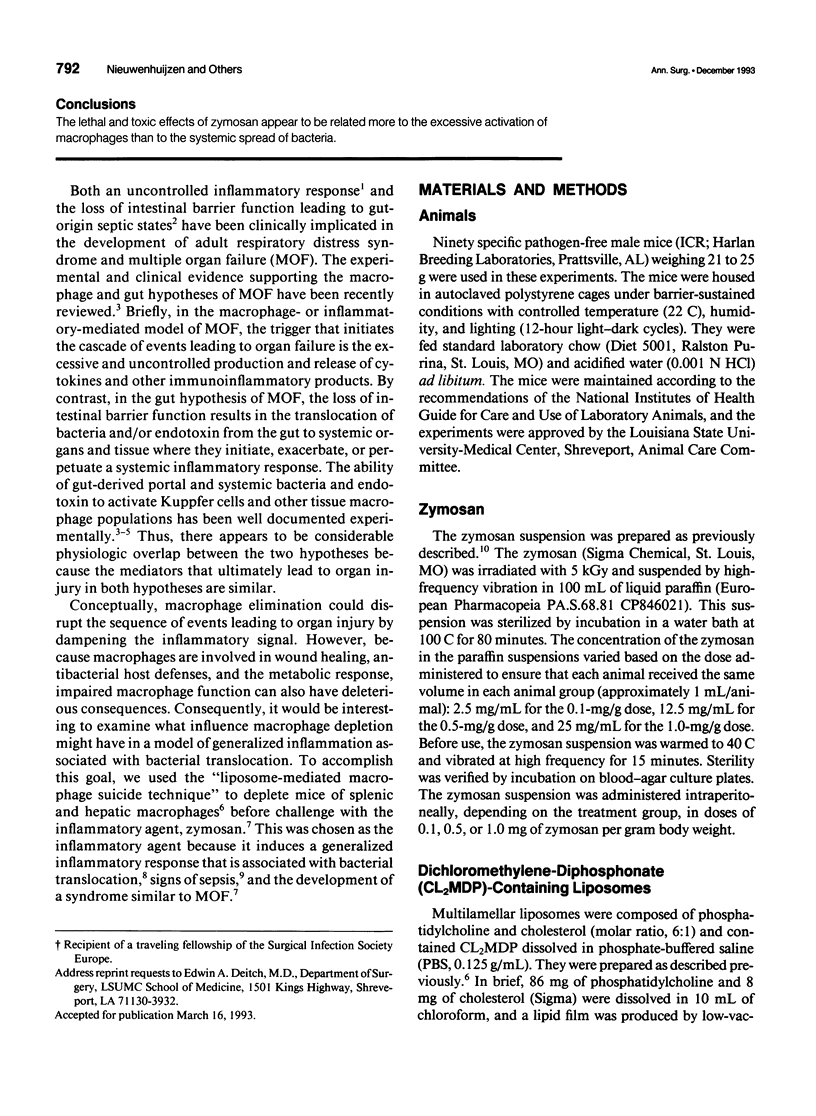
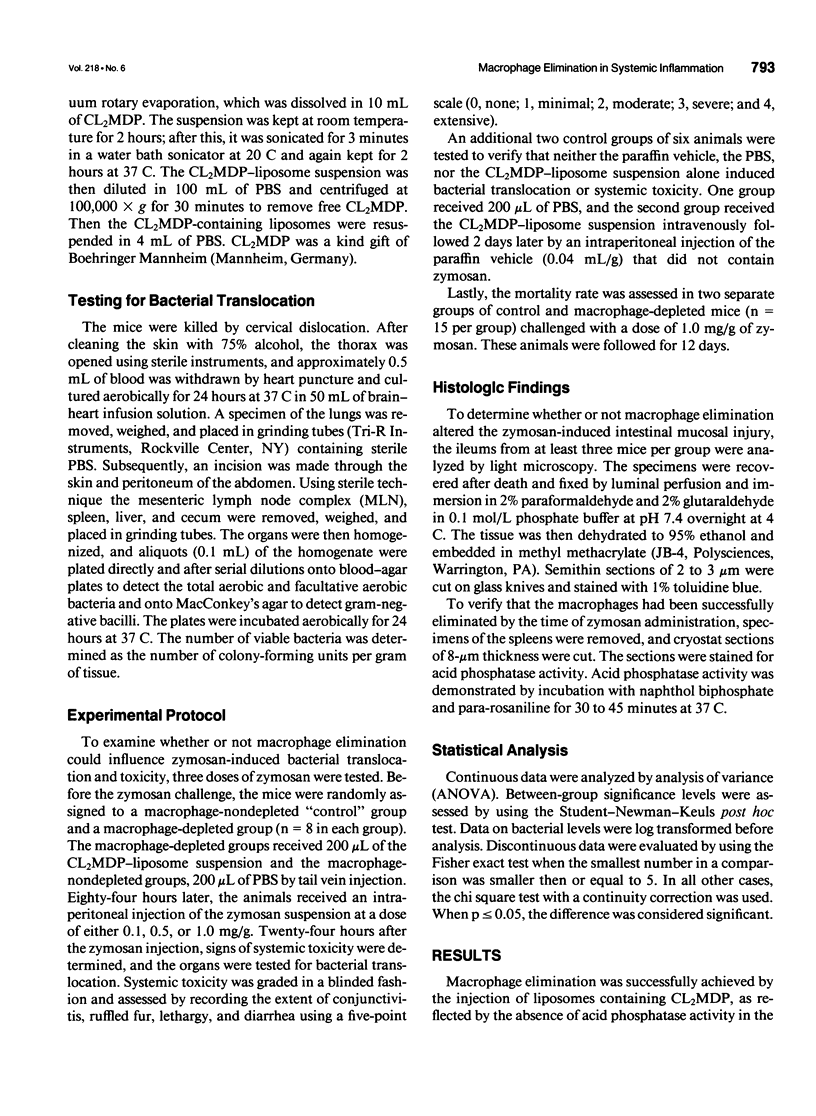
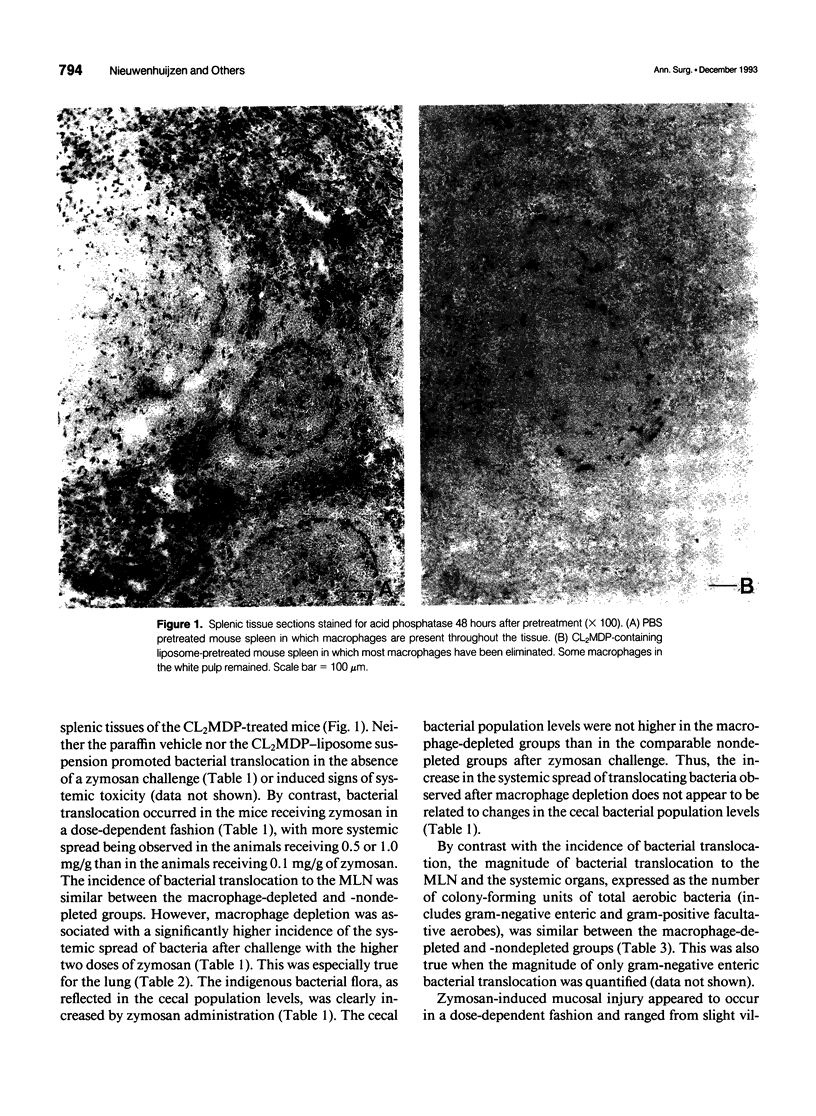
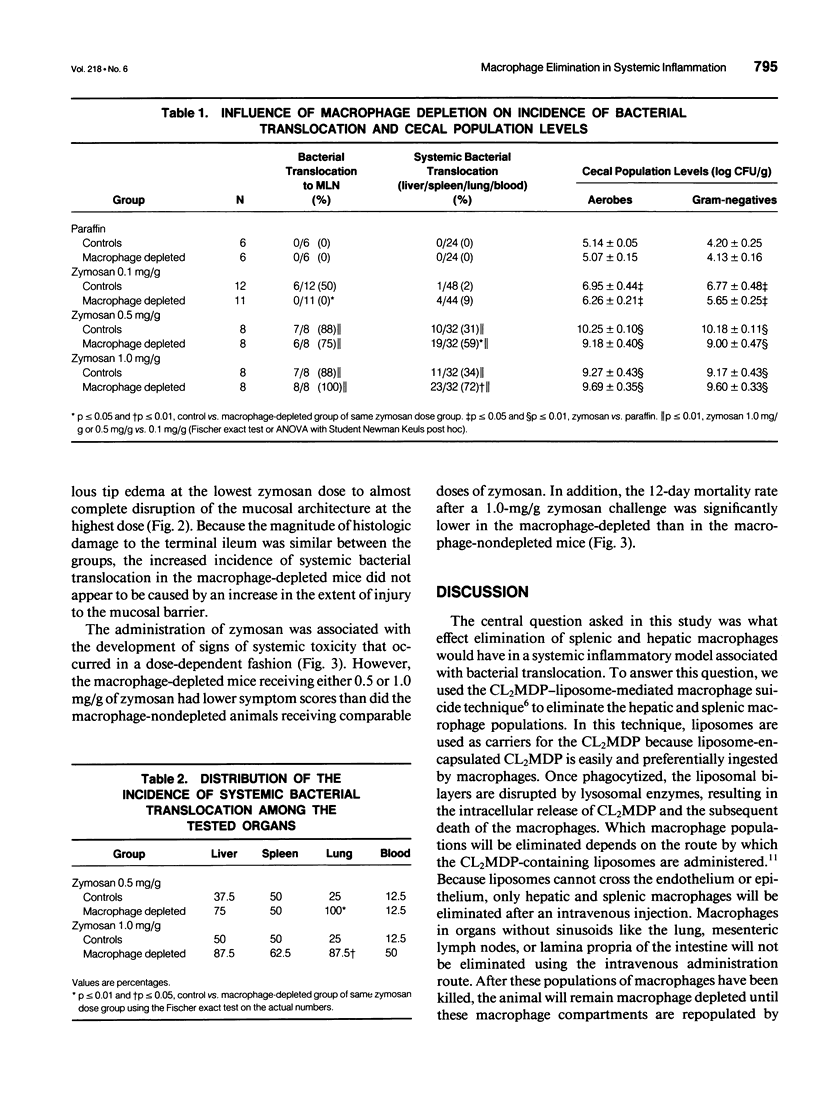
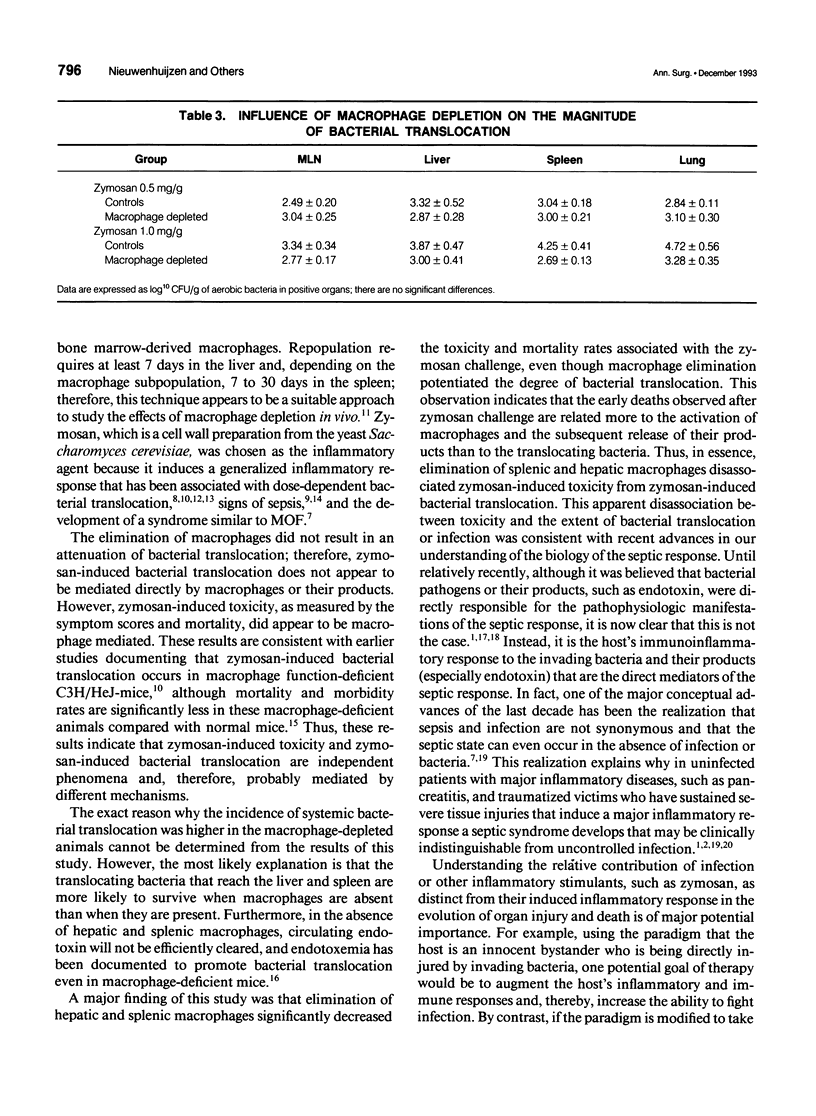
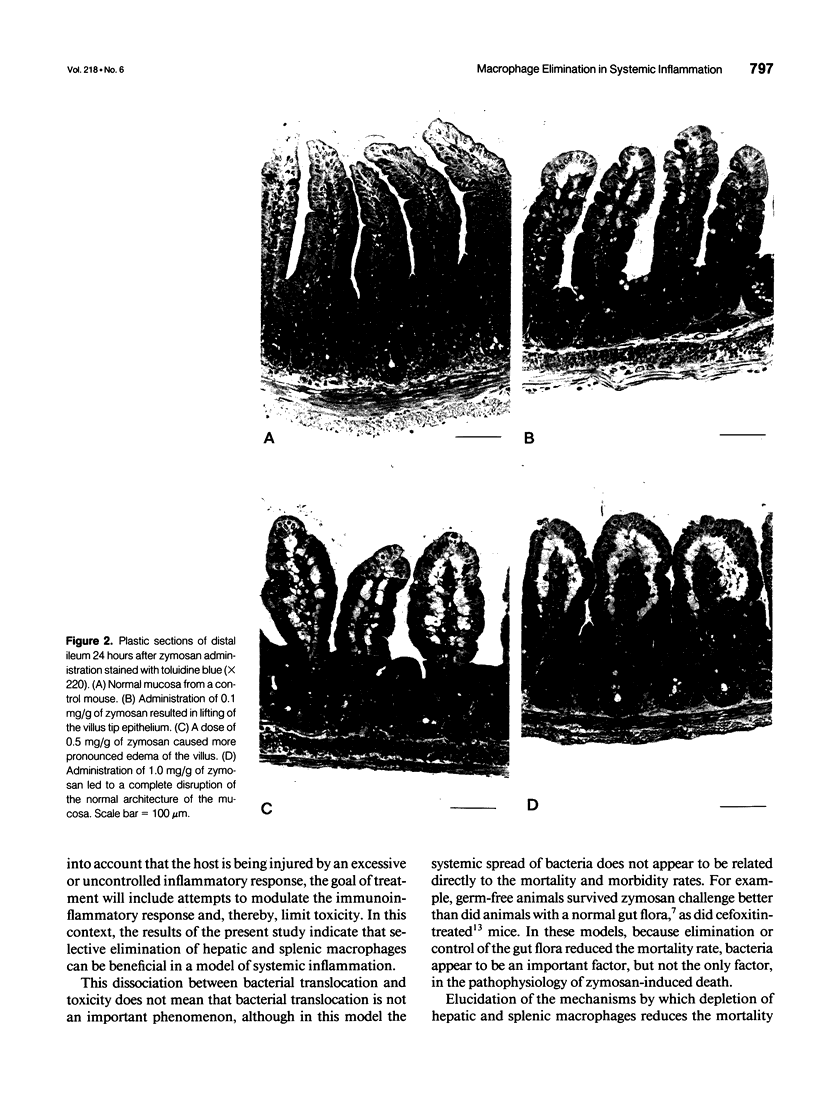
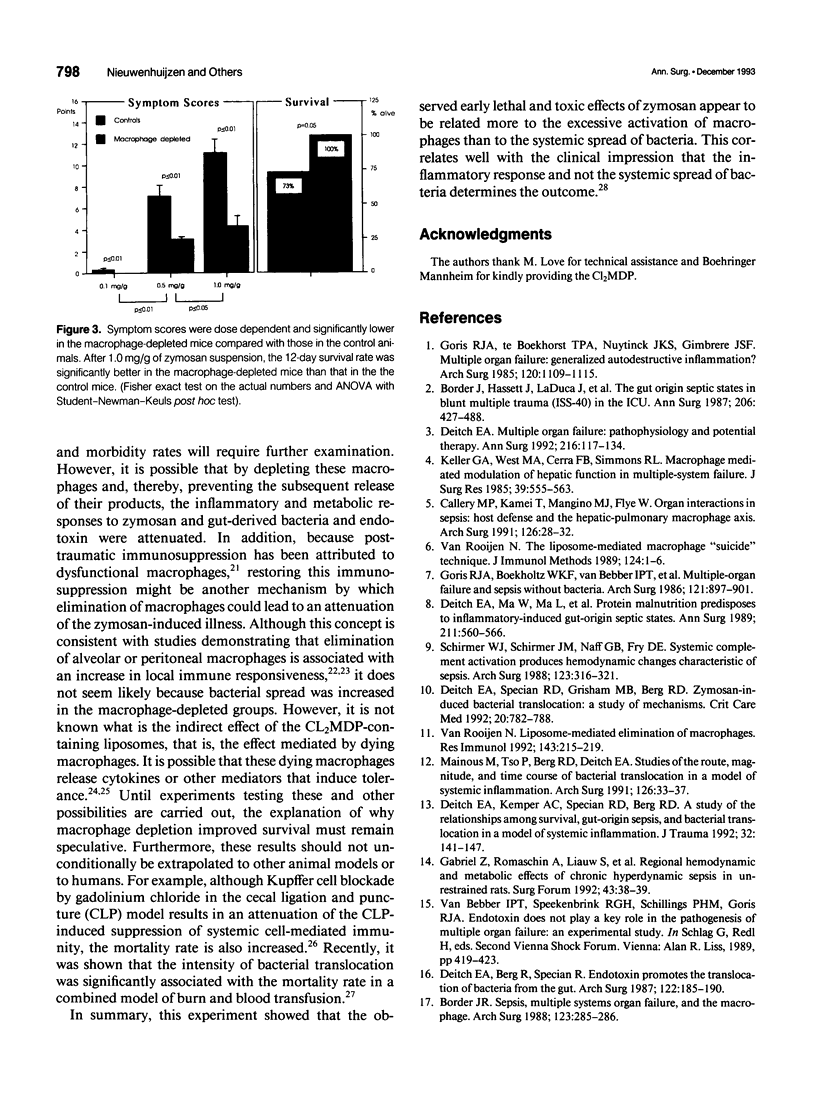
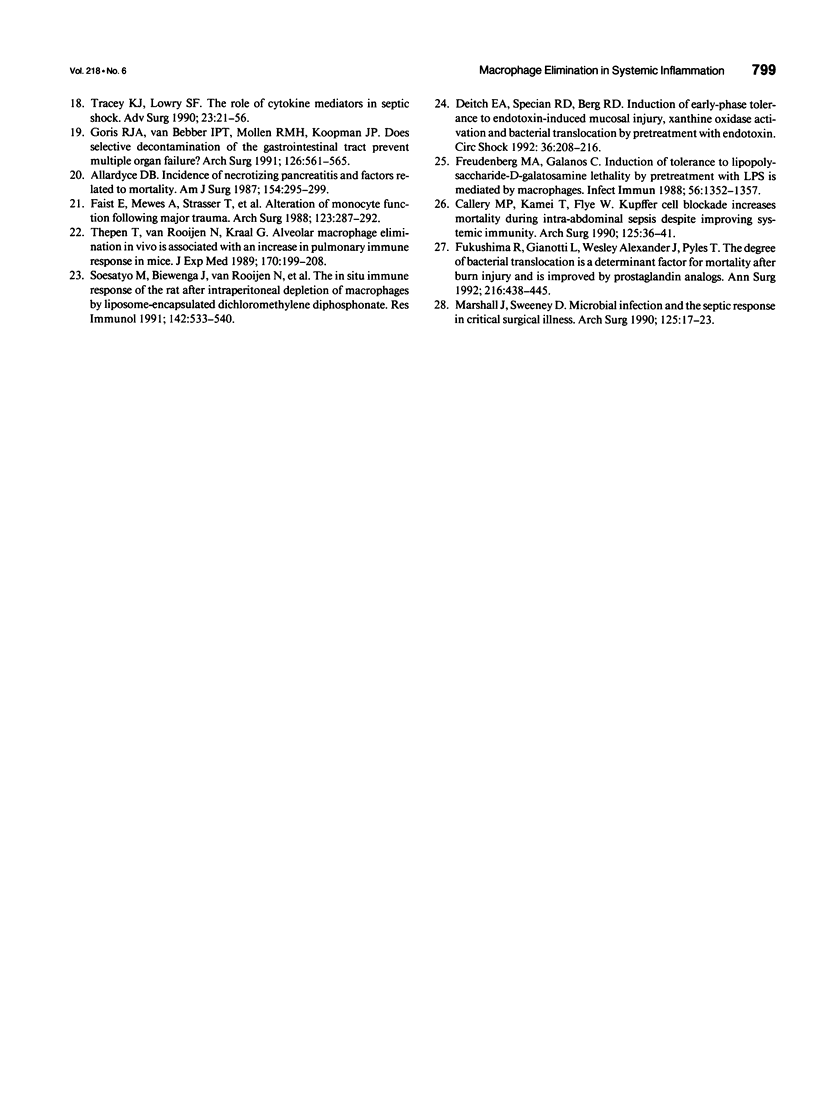
Images in this article
Selected References
These references are in PubMed. This may not be the complete list of references from this article.
- Allardyce D. B. Incidence of necrotizing pancreatitis and factors related to mortality. Am J Surg. 1987 Sep;154(3):295–299. doi: 10.1016/0002-9610(89)90614-4. [DOI] [PubMed] [Google Scholar]
- Border J. R., Hassett J., LaDuca J., Seibel R., Steinberg S., Mills B., Losi P., Border D. The gut origin septic states in blunt multiple trauma (ISS = 40) in the ICU. Ann Surg. 1987 Oct;206(4):427–448. doi: 10.1097/00000658-198710000-00004. [DOI] [PMC free article] [PubMed] [Google Scholar]
- Border J. R. Hypothesis: sepsis, multiple systems organ failure, and the macrophage. Arch Surg. 1988 Mar;123(3):285–286. doi: 10.1001/archsurg.1988.01400270019001. [DOI] [PubMed] [Google Scholar]
- Callery M. P., Kamei T., Flye M. W. Kupffer cell blockade increases mortality during intra-abdominal sepsis despite improving systemic immunity. Arch Surg. 1990 Jan;125(1):36–41. doi: 10.1001/archsurg.1990.01410130038005. [DOI] [PubMed] [Google Scholar]
- Callery M. P., Kamei T., Mangino M. J., Flye M. W. Organ interactions in sepsis. Host defense and the hepatic-pulmonary macrophage axis. Arch Surg. 1991 Jan;126(1):28–32. doi: 10.1001/archsurg.1991.01410250032004. [DOI] [PubMed] [Google Scholar]
- Deitch E. A., Berg R., Specian R. Endotoxin promotes the translocation of bacteria from the gut. Arch Surg. 1987 Feb;122(2):185–190. doi: 10.1001/archsurg.1987.01400140067008. [DOI] [PubMed] [Google Scholar]
- Deitch E. A., Kemper A. C., Specian R. D., Berg R. D. A study of the relationship among survival, gut-origin sepsis, and bacterial translocation in a model of systemic inflammation. J Trauma. 1992 Feb;32(2):141–147. [PubMed] [Google Scholar]
- Deitch E. A., Ma W. J., Ma L., Berg R. D., Specian R. D. Protein malnutrition predisposes to inflammatory-induced gut-origin septic states. Ann Surg. 1990 May;211(5):560–568. doi: 10.1097/00000658-199005000-00006. [DOI] [PMC free article] [PubMed] [Google Scholar]
- Deitch E. A. Multiple organ failure. Pathophysiology and potential future therapy. Ann Surg. 1992 Aug;216(2):117–134. doi: 10.1097/00000658-199208000-00002. [DOI] [PMC free article] [PubMed] [Google Scholar]
- Deitch E. A., Specian R. D., Berg R. D. Induction of early-phase tolerance to endotoxin-induced mucosal injury, xanthine oxidase activation, and bacterial translocation by pretreatment with endotoxin. Circ Shock. 1992 Mar;36(3):208–216. [PubMed] [Google Scholar]
- Deitch E. A., Specian R. D., Grisham M. B., Berg R. D. Zymosan-induced bacterial translocation: a study of mechanisms. Crit Care Med. 1992 Jun;20(6):782–788. doi: 10.1097/00003246-199206000-00015. [DOI] [PubMed] [Google Scholar]
- Faist E., Mewes A., Strasser T., Walz A., Alkan S., Baker C., Ertel W., Heberer G. Alteration of monocyte function following major injury. Arch Surg. 1988 Mar;123(3):287–292. doi: 10.1001/archsurg.1988.01400270021002. [DOI] [PubMed] [Google Scholar]
- Freudenberg M. A., Galanos C. Induction of tolerance to lipopolysaccharide (LPS)-D-galactosamine lethality by pretreatment with LPS is mediated by macrophages. Infect Immun. 1988 May;56(5):1352–1357. doi: 10.1128/iai.56.5.1352-1357.1988. [DOI] [PMC free article] [PubMed] [Google Scholar]
- Fukushima R., Gianotti L., Alexander J. W., Pyles T. The degree of bacterial translocation is a determinant factor for mortality after burn injury and is improved by prostaglandin analogs. Ann Surg. 1992 Oct;216(4):438–445. doi: 10.1097/00000658-199210000-00007. [DOI] [PMC free article] [PubMed] [Google Scholar]
- Goris R. J., Boekholtz W. K., van Bebber I. P., Nuytinck J. K., Schillings P. H. Multiple-organ failure and sepsis without bacteria. An experimental model. Arch Surg. 1986 Aug;121(8):897–901. doi: 10.1001/archsurg.1986.01400080039006. [DOI] [PubMed] [Google Scholar]
- Goris R. J., te Boekhorst T. P., Nuytinck J. K., Gimbrère J. S. Multiple-organ failure. Generalized autodestructive inflammation? Arch Surg. 1985 Oct;120(10):1109–1115. doi: 10.1001/archsurg.1985.01390340007001. [DOI] [PubMed] [Google Scholar]
- Goris R. J., van Bebber I. P., Mollen R. M., Koopman J. P. Does selective decontamination of the gastrointestinal tract prevent multiple organ failure? An experimental study. Arch Surg. 1991 May;126(5):561–565. doi: 10.1001/archsurg.1991.01410290033006. [DOI] [PubMed] [Google Scholar]
- Keller G. A., West M. A., Cerra F. B., Simmons R. L. Macrophage-mediated modulation of hepatic function in multiple-system failure. J Surg Res. 1985 Dec;39(6):555–563. doi: 10.1016/0022-4804(85)90124-6. [DOI] [PubMed] [Google Scholar]
- Mainous M. R., Tso P., Berg R. D., Deitch E. A. Studies of the route, magnitude, and time course of bacterial translocation in a model of systemic inflammation. Arch Surg. 1991 Jan;126(1):33–37. doi: 10.1001/archsurg.1991.01410250037005. [DOI] [PubMed] [Google Scholar]
- Marshall J., Sweeney D. Microbial infection and the septic response in critical surgical illness. Sepsis, not infection, determines outcome. Arch Surg. 1990 Jan;125(1):17–23. doi: 10.1001/archsurg.1990.01410130019002. [DOI] [PubMed] [Google Scholar]
- Schirmer W. J., Schirmer J. M., Naff G. B., Fry D. E. Systemic complement activation produces hemodynamic changes characteristic of sepsis. Arch Surg. 1988 Mar;123(3):316–321. doi: 10.1001/archsurg.1988.01400270050007. [DOI] [PubMed] [Google Scholar]
- Soesatyo M., Biewenga J., van Rooijen N., Kors N., Sminia T. The in situ immune response of the rat after intraperitoneal depletion of macrophages by liposome-encapsulated dichloromethylene diphosphonate. Res Immunol. 1991 Sep;142(7):533–540. doi: 10.1016/0923-2494(91)90098-4. [DOI] [PubMed] [Google Scholar]
- Tracey K. J., Lowry S. F. The role of cytokine mediators in septic shock. Adv Surg. 1990;23:21–56. [PubMed] [Google Scholar]
- Van Rooijen N. The liposome-mediated macrophage 'suicide' technique. J Immunol Methods. 1989 Nov 13;124(1):1–6. doi: 10.1016/0022-1759(89)90178-6. [DOI] [PubMed] [Google Scholar]
- van Bebber I. P., Speekenbrink R. G., Schillings P. H., Goris R. J. Endotoxin does not play a key role in the pathogenesis of multiple organ failure. An experimental study. Prog Clin Biol Res. 1989;308:419–423. [PubMed] [Google Scholar]
- van Rooijen N. Liposome-mediated elimination of macrophages. Res Immunol. 1992 Feb;143(2):215–219. doi: 10.1016/s0923-2494(92)80169-l. [DOI] [PubMed] [Google Scholar]




